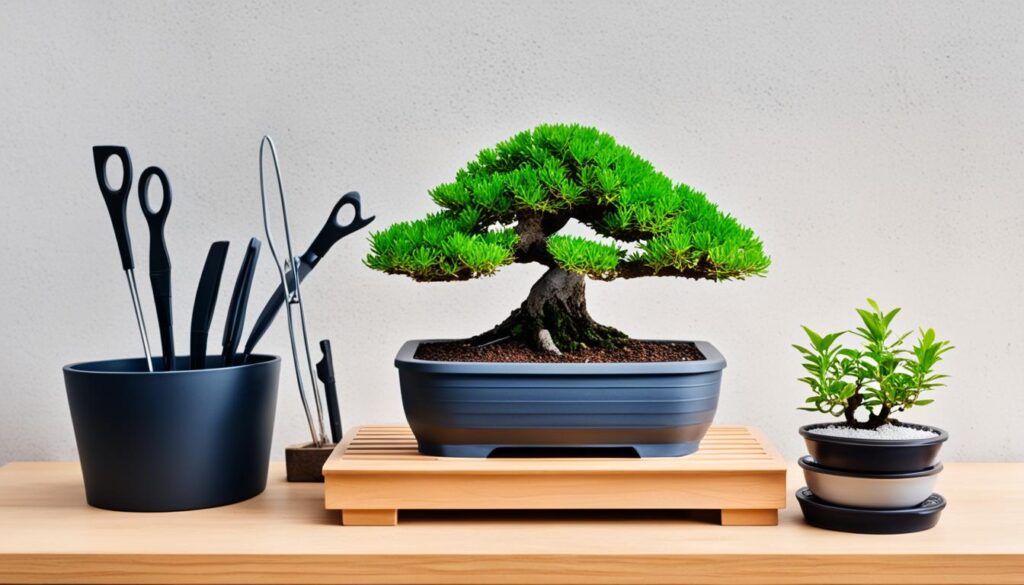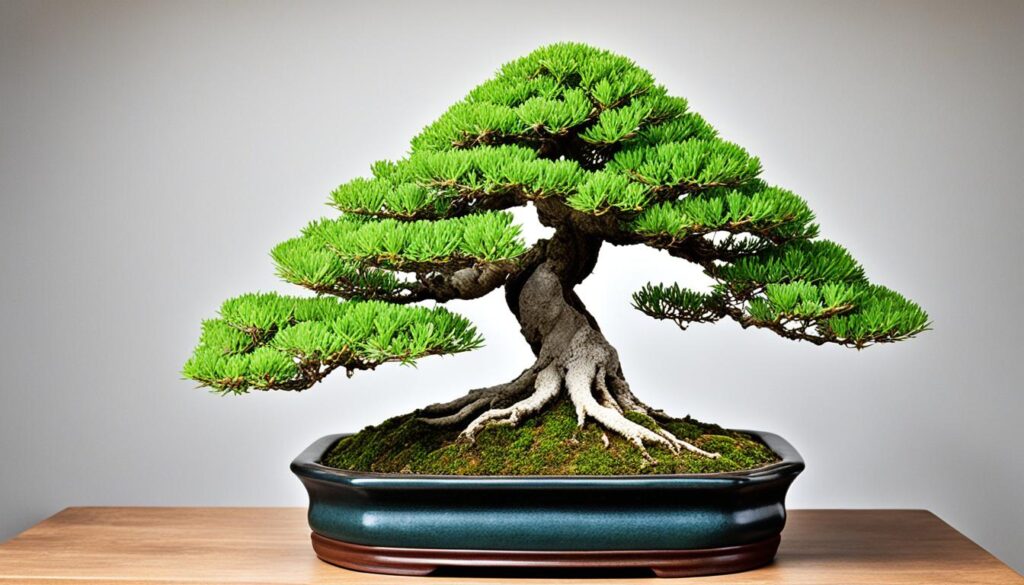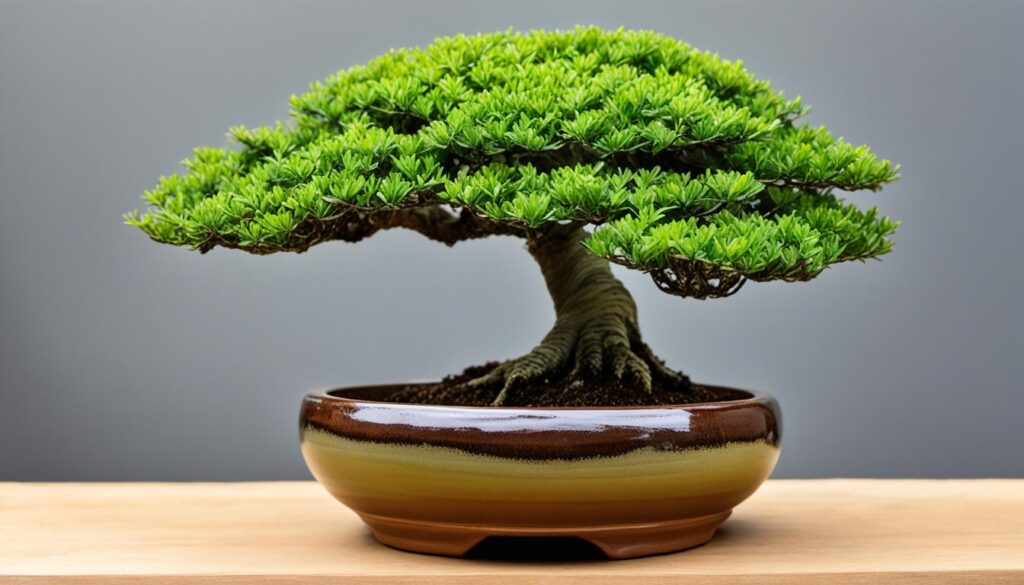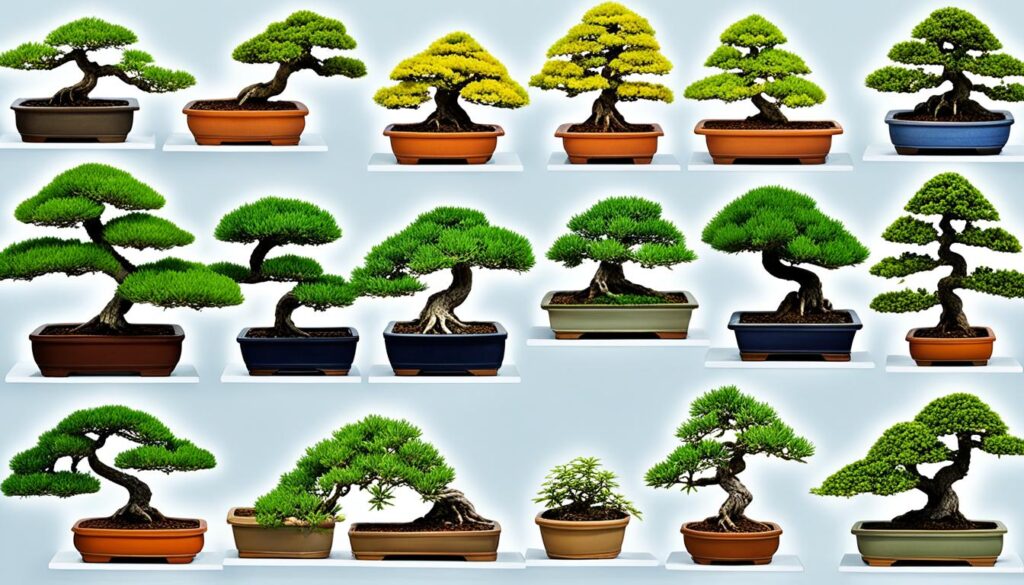Bonsai lovers often find that the pot for their trees is key to their growth and look. In fact, 92% of bonsai pros say the right pot is vital for showing off the tree’s beauty. This piece will explore the different pots out there, their benefits, and what to think about when picking the best one for your bonsai tree.
Key Takeaways
- The right bonsai pot can enhance or detract from the overall aesthetic of the tree
- Plastic nursery containers, colanders, and terra-cotta pots offer distinct advantages for bonsai
- Wooden boxes and containers can be customized for specific tree species and styles
- Pot dimensions, shape, and material all play a crucial role in the visual balance and health of the bonsai
- Considering pot quality and personal preferences can help unlock the full beauty of your bonsai tree
Introduction to Bonsai Pots
Bonsai pots are more than just containers; they’re key to the art of bonsai. They highlight the tree’s unique features and improve the overall look. Choosing the right pot can change how we see a bonsai, making it more beautiful and balanced. It’s important to know about the different types of pots and their features for growing and showing bonsai trees.
The ideal pot length is about 2/3 the tree’s height, and it should be slightly narrower than the tree’s widest branches. Some bonsai trees need repotting every year, while others can wait several years. If the tree looks like it’s stuck in the pot, it’s time to repot. If there’s enough soil and the roots aren’t cramped, you can wait another year.
Straight trunk trees look best in rectangular pots, while curved trunks fit oval or round pots better. Bigger pots help trees survive longer without water, especially in hot and dry places.
“Traditional rules suggest that the pot style should relate to the tree’s style and that powerful, rugged-looking trees should be planted in similar-looking pots.”
The pot’s shape should match the tree’s natural setting. Ceramic pots keep moisture well, making them great for bonsai, especially in cold weather. They come in many designs and colors. Clay pots let roots breathe and have earthy tones that match bonsai trees.
Plastic pots are light, strong, and affordable but might not look as good as ceramic or clay. Mica pots mix toughness with a natural look and protect roots from temperature changes. Concrete pots are good for big bonsai trees because they’re stable but might not have many designs and are heavy.
The color and design of bonsai pots can change how the bonsai looks. Earthy pots like brown or beige match bonsai trees and blend with the environment. Bright pots stand out. Glossy pots add elegance and make the bonsai more attractive, while rustic textures give a traditional feel and bring nature inside.
Plastic Pots for Bonsai
Many think of traditional pottery when they hear bonsai. But, plastic pots are great for young bonsai trees and those in the early stages. [https://amzn.to/4cSG0rS] Plastic bonsai pots are light, strong, and affordable. They’re a smart choice for growers.
Anderson Flats
Anderson flats are a special kind of plastic pot for bonsai. They have a mesh bottom that lets air get to the roots. This helps prevent fungal problems and ensures good drainage. Good drainage is key for keeping bonsai trees healthy.
Nursery Containers
Nursery containers for bonsai are also great for young trees that need to grow fast. They’re deeper than wide, giving trees more moisture and room to grow. This helps the bonsai container materials do well.
Plastic pots are a versatile and affordable choice for bonsai growers. They’re perfect for beginners or for trees in the early stages of development.

Colanders and Pond Baskets
Choosing the right container is key for bonsai trees. Colanders and pond baskets are great for bonsai growth. They help develop strong roots, which is vital for bonsai health and beauty.
Colanders have many small holes, perfect for pines. These holes make the roots grow wider, creating a beautiful base. Pond baskets also help roots grow but last longer, up to 5-10 years.
“Growing bonsai in baskets can result in significant growth, with the baskets outpacing bonsai pots noticeably over time.”
Studies show colanders for bonsai and pond baskets for bonsai are beneficial. In a test with Japanese Black pine trees, trees in perforated containers did better than those in pots. They had better roots and looked more appealing.
For those who love bonsai, colanders and pond baskets are a great choice. They help bonsai trees grow and look their best. Using these containers can make bonsai trees truly stand out.
Terra Cotta Pots for Bonsai
As bonsai trees grow, they often move from plastic pots to terra cotta ones. These pots are perfect for young trees, bare-root bonsai, and trees not yet ready for their first pot. They fit well with species like azalea bonsai containers, offering extra space for roots to grow.
Many pine bonsai switch to terra cotta pots when their trunks get thick enough. This step helps focus on branch growth. Transitional pots act as a middle step, helping trees adjust before moving to their final pots.
Transitional Pots
Terra cotta pots are a top pick for bonsai container materials because they breathe and control temperature. They’re great in hot weather, keeping the soil cool and moist.

The porous nature of terra cotta also means better air flow around the roots. This is key for the health and growth of bonsai pot proportions. Choosing the right material, size, and shape is crucial for our trees to thrive.
Wooden Boxes and Containers
Wooden boxes and containers are great for bonsai lovers. They let you make custom-made homes for your bonsai tree. This is especially good for deciduous bonsai because they do well in wide containers that help their roots grow.
Many bonsai fans use leftover wood to make their own containers. Up to 50% of them prefer making their own. These homemade containers fit perfectly and have great drainage, which is key for bonsai pot sizing. It’s important to avoid wood that has been chemically treated and to use small drainage holes to keep the soil in place.
“Wooden boxes can also be a good choice for refined bonsai that have lost vigor, as the slightly larger size provides room for the tree to regain its strength over a few years.”
Building wooden bonsai containers can be fun and a great way to meet others. Bonsai lovers often come together to share tips, stories, and build custom bonsai pots. These pots are both useful and beautiful.
The size and design of these wooden boxes can change. Some people choose a 10-degree angle on the sides and a bottom with a big drainage screen or wooden struts. The containers can last about two to five years, making them a good investment for bonsai fans.
Bonsai Pot Materials
The type of pot used for bonsai greatly affects the tree’s health and look. Pots come in many materials, each with its own benefits for different trees and conditions. Glazed and unglazed pots are two main types.
Glazed vs Unglazed
Unglazed pots, like those from terra cotta, are great for evergreen bonsai. They let air and water reach the roots, which is key for the tree’s health. These pots also don’t take away from the tree’s beauty.
Glazed bonsai pots offer bright colors that match deciduous and flowering bonsai. They keep moisture in, which is good for trees in dry places.
Choosing the right bonsai pot means thinking about the tree’s needs, the climate, and the look you want. Knowing about different pot materials helps you pick the best one for your bonsai’s health and growth.
“The pot is half the bonsai.” – Unknown

What type of pot is best for a bonsai tree?
Choosing the right pot for a bonsai tree is key to its health and look. There’s no single “best” pot for all trees. The right pot depends on the tree’s type, growth stage, climate, and your taste.
Bonsai tree pots can cost a lot, from hundreds to thousands of dollars. But, you can find good pots for less than $100 or even $20 with some searching. The important thing is to pick a pot that makes the bonsai look great and helps it grow well.
When picking a pot, think about its size, shape, and material. The pot’s depth should match the trunk’s diameter for a real bonsai look. Drainage holes are also key to keep the roots healthy and the tree thriving.
The pot’s shape can change how the bonsai looks. Thick-trunked, dense trees fit well in rectangular or square pots. Trees with fine features look better in oval or rounded pots.
The best bonsai pot type is one that fits the tree’s needs and looks good with it. With some research and advice from bonsai experts, you can find the perfect pot for your bonsai.
Pot Size and Dimensions
The size and dimensions of the pot are key for bonsai trees. They affect the tree’s balance and health. A good rule is to make the pot’s height, length, and depth about the same as the tree’s height. This makes the tree look good and stable.
The right bonsai pot size depends on the tree type, its roots, and how fast it grows. Big trees need deeper pots, while small ones do well in shallower ones.
- Rectangular or oval bonsai pots ideally have a width of approximately 2/3 the height of the tree.
- Round bonsai pots should have a diameter approximately 1/3 the height of the tree.
- Pots for trees with a wider branch span than height should be approximately 2/3 the length of the span.
- The depth of the pot should be approximately the same width as the trunk at its base.
When you’re repotting, think about the bonsai pot proportions and bonsai pot sizing formulas. For instance, a tree in a 6.5″ pot might need a new pot that’s about 8.5″ wide and 2.75″ deep.
“It is generally safe to remove up to 1/3 of a plant’s roots with each repotting.”
For new bonsai owners, deeper pots are usually better than shallow ones. They offer more support and stability for the tree.

Pot Shape and Style
The shape and style of the pot greatly affect a bonsai’s look. Round or square pots make the tree look taller and more upright. They are perfect for trees that grow straight up. On the other hand, oval or rectangular pots show off the tree’s width and its horizontal growth.
Equal vs Unequal Sided
The pot’s shape depends on the bonsai tree’s style and look. For instance, square pots are great for cascade trees because they keep branches from touching the pot. Rectangular pots make informal upright trees look strong. Oval pots are good for deciduous trees and fit well with clump or forest bonsai. Round pots are ideal for conifer and deciduous trees, fitting well with literati or cascade styles.
The bonsai pot’s shape and style should match the tree’s look, making a beautiful display. Knowing about pot shapes helps bonsai lovers choose the right one. This way, they can make their trees look their best.
Pot Color Choices
The color of a bonsai pot greatly affects the look of the tree. Growers often match the pot’s color with the tree’s leaves or choose pots that stand out. This makes the bonsai more beautiful.
For evergreen species, growers like unglazed, neutral-toned pots. These pots let the tree’s beauty shine. For deciduous and flowering bonsai, glazed pots in many colors work well. Some people change pots with the seasons to highlight the tree’s changing look.
- Unglazed, earthenware pots are preferred for needle-evergreen trees.
- Glazed pots are commonly used for flowering or fruiting trees.
- Pots for Japanese or Korean maples often range from light gray to dark brown, softly contoured to fit the tree.
Some bonsai types need special pots. For example, cascade and literati style pots have unique shapes. Cascade pots can be round, square, or hexagonal and are often brightly glazed. Literati style pots are small, round, shallow, and handmade if plain.
“The color of the pot can significantly impact the overall aesthetic of the bonsai, allowing growers to create harmonious or contrasting displays throughout the year.”
Choosing the right bonsai pot color and style can make the bonsai look amazing. It lets growers show off their trees in beautiful ways all year.

Pot Design Elements
The pot for your bonsai tree is more than just a container. It’s a key part of the tree’s look. Design elements like intricate patterns and shapes add to the bonsai aesthetics. The rim, sides, and feet of the pot all affect how it looks.
Outer-rimmed pots suit deciduous and flowering bonsai, while straight-rimmed pots are better for evergreens. The pot’s sides can be straight, angled, or curved. Decorative features like paint or unique feet can make smaller bonsai pot features stand out.
Choosing the right bonsai pot design is key. It must match the tree’s size, shape, and growth. This careful choice makes sure the pot and tree look great together, creating a beautiful display.
The bonsai pot design is vital to bonsai art. It enhances the tree’s beauty and makes it a sight to behold for anyone who sees it.
Container Quality Matters
As a bonsai enthusiast, the quality of your tree’s container is key to its look. An inexpensive pot might do at first, but as you grow in skills and love for bonsai, you might want better pots.
Well-made pots, by famous artists or chosen with care, can make your bonsai look better. They don’t just help with watering but also make your bonsai look great. These pots add to the bonsai aesthetics and bonsai display.
Bonsai pots need drainage and wiring holes and should be a bit off-centered for looks. Plastic pots are good and last long, especially when you’re starting with a bonsai.
“The quality of the bonsai container craftsmanship can significantly impact the overall presentation of the tree.”
As your bonsai collection gets bigger, you might look for different styles and bonsai pot quality. You might like Chinese, Yamaaki, Japanese, or Nanban pots. Each style has its own look and fits certain trees better.

Choosing the right container for your bonsai is very important. It affects the tree’s growth and how it looks. By picking high-quality bonsai containers, you make your bonsai look better and share your love for this art with others.
Conclusion
Choosing the right bonsai pot is key to the art’s success. The pot helps show off the tree’s beauty and supports its growth. By knowing the different types of pots, their materials, shapes, and designs, growers can pick the best for their trees.
A simple terra cotta pot or a custom wooden one can change how we see the tree. Every detail, from the pot’s sex to its size and color, matters. It helps create a perfect bond between the bonsai and its pot, letting the tree’s true beauty shine.
There are many options for bonsai pots, both online and from local experts. Enthusiasts can find the perfect pot for their trees. This enhances bonsai aesthetics, bonsai container characteristics, and bonsai growing tips. With the right bonsai pot selection, growers can keep their trees healthy and beautiful. This creates a stunning display that celebrates nature’s beauty.



Thank you for your sharing. I am worried that I lack creative ideas. It is your article that makes me full of hope. Thank you. But, I have a question, can you help me?